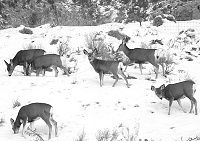| Utah Division of Wildlife Resources are concerned that the state’s deer and elk populations are at risk of contracting the deadly chronic wasting disease. The first confirmed case of the disease in the state was discovered earlier this week and was found in a deer from northeastern Utah near Vernal. The deer was harvested last fall, but test results were only recently discovered. Wildlife officials believe that the disease may have came from a Colorado herd near the eastern Utah border. |
It is official. Chronic wasting disease has found it’s way into Utah.
The Division of Wildlife Resources announced earlier this week that a buck deer taken by a hunter in northeastern Utah this fall has tested positive for the deadly disease.
The deer was harvested on Diamond Mountain which is located just north of Vernal. The discovery of an infected mammal now has the attention of wildlife officials and hunters across the state.
“DWR has been looking fro chronic wasting disease in Utah since 1998,” explained big game coordinator for the wildlife division, Jim Karpowitz.
“When the Colorado Division of Wildlife Resources discovered a deer positive with the disease near the town of Craig in early 2002, we decided to intensify our surveillance efforts, focusing on mule deer populations along the Colorado border,” Karpowitz continued.
According to the wildlife agency, nearly 1,500 brain samples were collected from deer and elk in Utah in the fall of 2002. Almost 1,400 of the deer and elk have been tested for the disease so far with only one sample testing positive.
“Finding chronic wasting disease in Utah is sad, but it was just a matter of time before it hit us in Utah, commented Rocky Mountain Elk Foundation regional director, Bill Christensen.
“There’s no need to panic, but we need to increase testing and continue to support research into the disease,” concluded Christensen.
Chronic wasting disease is not caused by a virus or bacteria. Rather, infectious proteins called prions seem responsible.
Prion caused diseases are known as transmissible spongiform encephalopathies. One such example of this prion caused illness is mad cow disease.
Diseases caused by prions and their methods of transmission are not well understood. However, it is thought that chronic wasting disease spreads from animal to animal through direct contact at food or water sources.
The infected animal will develop brain lesions, become emaciated, appear listless and droopy, may salivate excessively and eventually die from the disease. Although infected, the animal may not show signs of the disease until 36 months after first coming in contact with the disease. The animal may also live for as long as five years after becoming ill with the deadly disease.
There is no evidence however that the disease naturally infects other big game species or domestic livestock. It is thought that only deer and elk populations suffer from this specific disease.
More importantly, the World Health Organization reports that there is no scientific evidence to date that chronic wasting disease is transmissible to humans.
The lack of evidence however, does not prove humans are safe from the disease. Research in this area is continuing and until more is known about the disease, hunters directly exposed to game animals are advised to take some minimal precautions to ensure safety.
The wildlife division advises hunters to take these simple precautions when handling the carcass of any deer or elk.
•Do not handle or consume wild game animals that appear sick.
•Wear rubber or latex gloves when field dressing big game.
•Bone out the meat or at least avoid consuming the brain, spinal cord, eyes, spleen and lymph nodes of harvested animals.
•Minimize handling of the soft tissues and fluids. Wash hands with soap and warm water after handling any parts of the carcass.
Chronic wasting disease can come into a state through the natural movement of wild deer and elk or the interstate shipment of hunter harvested or captive white-tailed deer, mule deer or elk.
Scientists are not certain, but it is possible that the carcass of infected deer or elk may be a way of spreading the disease.
The DWR also has taken measures to prohibit the import of deer and elk carcasses from known infection areas.
Only the following parts of wild deer and elk may be imported from designated infection areas from other states.
•Meat that is cut and wrapped either commercially or privately.
•Quarters or other portion of meat with no part of the spinal column or head attached.
•Meat that is boned out.
•Hides with no heads attached.
•Skull plates with antlers attached that have been cleaned or all meat and tissue.
•Antlers with no meat or tissue attached.
•Upper canine teeth known as buglers, whistlers or ivories.
•Finished taxidermy heads.
•Non-residents transporting harvested deer and elk carcasses through Utah may do so if they do not stay in the state more than 24 hours.
There is considerable concern that the disease will spread into additional Utah deer and elk populations.
The DWR will conduct random samplings of harvested deer and elk to check for the disease, especially in eastern Utah.
The wildlife division is also considering implementing additional measures to inhibit the spread of the disease.
“It also does not appear that the disease causes catastrophic die offs in deer and elk populations,” commented Karpowitz.
A great deal of research is being conducted by many agencies and organizations to learn more about this relatively new disease.
“Until more is known, we’ll continue to be diligent with our surveillance and management efforts and provide the public with the most current information available,” Karpowitz concluded.
Carbon County residents can learn more about chronic wasting disease by visiting the division’s website at www.wildlife.utah.gov/hunting/biggame/cwd.

